Groundwater - surface water interactions
To view the information PDF requires the use of a PDF reader. This can be installed for free from the Adobe website (external link).
Background
The Victorian Government is committed to managing water resources to support a thriving economy, healthy environment and growing communities (Victorian Government White Paper: Securing Our Water Future Together), and DPI is supporting this commitment through Future Farming Strategy Action 4 'Strengthening land and water management'.
In order to manage our water resources there is a need to understand how climate change and land use change impact on Victoria's water resources. This project will investigate the role of surface and groundwater systems in the Goulburn and Ovens river catchments - in particular, how they respond to changing land use and climate conditions, the rivers' connection to landscapes and interactions between surface and groundwater systems.
Overview
Groundwater and surface water have traditionally been studied and managed as separate resources. However in recent years the interactions between the two water resources have been acknowledged in Australia, and indeed internationally, as being a major area of weakness in our understanding of catchments, to the detriment of water resources and environmental management.
Numerical models developed to date have generally not accounted well for groundwater-surface water interactions. There has been limited attention given to considering the groundwater and surface water systems together, and to accurately conceptualising and parameterising the groundwater-surface water interface. The key objectives of this research are therefore:
- to increase our conceptual understanding of the role of surface and groundwater resources in determining the functionality of off-channel habitats.
- to investigate the impacts of climate, irrigation and groundwater pumping on groundwater interactions with floodplain ecosystems.
- to inform catchment water balance modelling with groundwater connection
- to identify the regulation impacts on groundwater/stream interaction by comparing the Goulburn (regulated) and Ovens (unregulated) river systems.
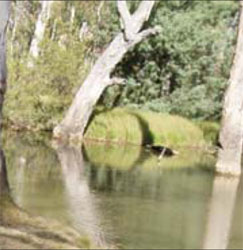 | 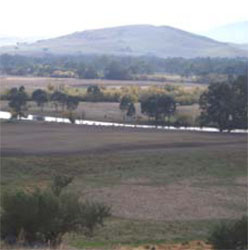 |
| What are groundwater - surface water interactions? Groundwater - surface water interactions occur when water flows between surface and groundwater systems. Streams and groundwater interact in all types of landscapes with significant variation in the nature and degree of connectivity between surface water and groundwater systems. Interaction may be described as occurring in three basic ways: | |
| 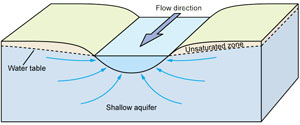 |
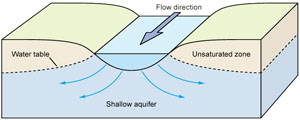 |
|
Images taken from Catalogue of conceptual models for groundwater - stream interaction in eastern Australia (external link)
Methodology involved in the study
This research will focus on the floodplains near identified environmental assets along the Goulbourn and Ovens rivers as well as key tributaries. The research involves:
- identifying gaining, losing and variably gaining-losing river reaches by analysing stream flow data, water usage history and on-site evaluation.
- conceptualising the processes of groundwater-stream interactions by constructing cross-sections with bore transects perpendicular to the floodplains and comparing groundwater data with stream data (e.g. water level and salinity)
- investigating the impacts of groundwater extraction and irrigation on river flows by assessing connectivity between aquifers and streams and analysing groundwater hydrograph behaviour
- assessing vertical hydraulic connectivity between aquifers by analysing hydrographs of nested piezometer sites.
- identifying knowledge gap and recommending future data acquisition work and research that will advance the understanding of dynamic of groundwater-stream interactions.
Government, policy makers, scientists and land managers are better informed on the interactions between surface and groundwater systems, enabling improved water resource allocation as well as river and floodplain management.
| How does groundwater pumping affect surface waters? The interactions between groundwater and surface water can be significantly affected by water use and management within the catchment. For example, in a stream system that is gaining water from natural groundwater inflow (A), groundwater pumping may reduce the rate of inflow to the stream (B), or if the rate of groundwater pumping is sufficient the stream may become a losing stream and provide recharge to the groundwater aquifer (C) (after Winter et al. 1998). Images taken from Catalogue of conceptual models for groundwater - stream interaction in eastern Australia (external link) | 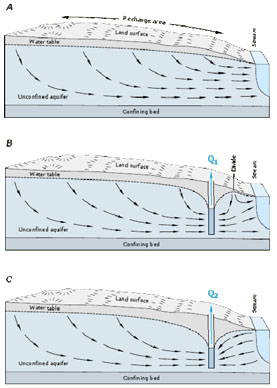 |


